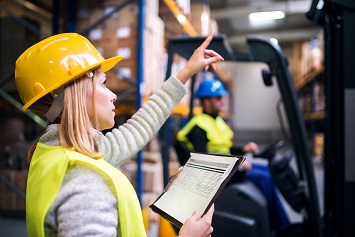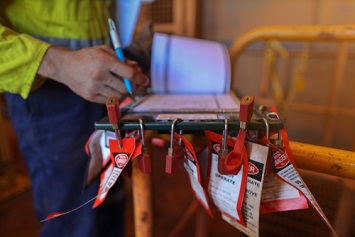Warehousing is one of the riskier industries due to the use of high-powered machinery and vehicles operating within close proximity of each other. Warehouse safety should be your utmost priority to keep employees safe, ensure efficient operation, maximize productivity, and minimize injury or damage.
To instill safety procedures in a warehouse, display easy-to-read safety notices and warnings, encourage and provide the opportunity for employees to get additional safety certifications, and continuously revisit safety protocols to ensure they remain up to date. Many resources devote themselves to providing comprehensive and detailed instructions for warehouse operations and safety.
Establishing Safety Procedures
The Occupational Safety and Health Administration (OSHA) reports thousands of injuries, illnesses, and deaths in the warehousing industry annually, many of which are caused by workplace accidents such as slips or falls, hazardous materials, equipment malfunction, and more.
Establishing safety procedures can help prevent workplace accidents in warehouses and promote an environment where safety is prioritized. A good safety procedure for a warehouse starts from the top down, building such values into the company culture. Below are some key factors to consider when putting together a plan for a safe environment for warehouse employees.
Safety Information Resources
While warehouse workers may perform their job flawlessly, not everyone is aware of all the proper safety procedures. All employees may have the necessary required certification for the job, but this does not always include in-depth safety training.
Provide ample opportunities for employees to be exposed to safety resources, including signage, safety stickers, regular meetings, safety training, and options to enroll in auxiliary certification programs.
Post signs around the warehouse indicating different kinds of safety procedures, make announcements regarding new safety procedures, and recognize employee efforts to demonstrate exemplary safety protocol. Consider putting together an employee handbook or manual that includes safety procedures.
If your employee demographic has any nonnative English speakers, ensure signage and safety stickers are multilingual. Visual cues, like a specific color—such as red for danger or yellow for caution—can alert your employees to hazards and help keep them safe.
Incentivize workers to take safety courses by providing them on behalf of the company. Warehouse workers are more likely to take safety seriously when they know the company is responsible, accountable, and invested in their well-being.
Daily Protocol
Having a general daily protocol can help establish a safe working environment out of habit. The protocol can include reporting in, collecting safety equipment, cleaning and preparing the work space, checking all necessary equipment, and closing down at the end of the day. Such habits encourage a daily check-in at the warehouse by all employees, promoting awareness, responsibility, and accountability. Workers who regularly clean their areas and take extra safety precautions can significantly reduce some warehouse dangers.
To ensure regular daily protocol, find ways to incentivize employees, and make warehouse safety part of their daily life. Consider having an employee of the month, giving bonuses for exemplary safety behavior, or promoting employees who show superior safety techniques. Make warehouse safety a concern that all employees take seriously—not just a work requirement.
Storage and Organization Standards
Many injuries and incidents in warehouses can occur because of trip hazards and unclear walkways. Materials and equipment left in paths, spills, and loose cables can all cause a great deal of damage or injury if a worker does not see them. Maintaining organized work spaces and making sure there are no obstructions in the way of workers, forklifts, and any other equipment can greatly reduce the risk of such injuries.
There are a number of simple ways to avoid hazards and establish safe practices for stacking, storing, loading, and unloading products and equipment.
Clearing walkways of unnecessary materials or equipment and returning things to their place when done reduces the risk of trips and falls. Many walkways and storage areas may have high-stacked shelves or pallets, and it is important to ensure they are not overstacked or stacked carelessly. Establish proper stacking procedure and height limits to keep things from falling on employees below.
Lockout/Tagout Procedure
Warehouses contain a lot of heavy machinery with many moving parts and hazardous energy and materials. Therefore, it is extremely important to establish a safe and precise lockout/tagout procedure for all employees to follow. This allows all workers and technicians involved with the operation and maintenance of equipment and machines to follow the exact protocol, ensuring the highest level of safety in your warehouse.
An employee or a technician should be trained in how to use the machine, shut it down correctly, isolate the power sources, and lock and tag the machine in a safe off position. By incorporating a detailed lockout/tagout procedure, machines and heavy equipment can be safely maintained, preventing any loose parts or built-up energy from injuring a worker.
When a machine or piece of equipment is scheduled for downtime or maintenance, a trained employee must notify all relevant staff members of the lockout and follow correct lockout/tagout procedures by adhering to operational instructions.
Post detailed operational instructions at each machine, as well as provide employees with lockout/tagout kits. Your operational instructions should include details on the machine’s moving parts, power sources, and start-up and power-down processes.
The Takeaway
Warehouses can be dangerous places, as they are fast-paced and involve equipment such as forklifts, trucks, conveyor belts, and other heavy machinery. These items can be extremely dangerous if not handled safely, and it is vital you train your employees to prevent damage, injury, illness, or death due to the improper handling of equipment or materials or employee negligence.
Warehouse safety is an essential part of any warehouse operation. It is important to provide a safe environment for workers to conduct work without unnecessary and avoidable hazards. Warehouse safety starts with educating workers and promoting a safe workplace by providing sufficient tools for employees to use. When safety is made an inherent part of the company culture, employees are more likely to adhere to safety practices and want to learn more.
 David Morrison is the Director of Business Development for Panduit and General Manager of ThunderID, a trusted adviser that works to address businesses’ most critical challenges within their data center, enterprise, and industrial environments. David Morrison is the Director of Business Development for Panduit and General Manager of ThunderID, a trusted adviser that works to address businesses’ most critical challenges within their data center, enterprise, and industrial environments. |


